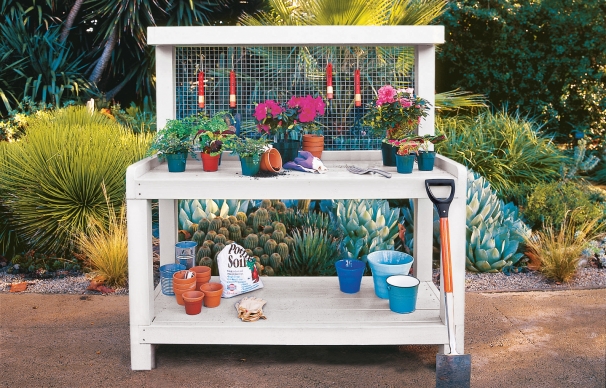A potting bench provides a good-sized work surface and a designated place to keep your tools and supplies organized. It is a must-have staple if you take gardening seriously. It saves your back from stooping over low work surfaces and can double as an outdoor bar.
There are tons of potting benches out there. So how do you pick one that is perfect for your needs? Keep reading, and you will find out in a bit.
How To Arrive At The Perfect Choice Of A Potting Bench For Your Gardening:
Height:
One of the advantages that potting benches offer is the ability to work without bending over. This means that the height of the ideal potting bench should be something around that of an average kitchen sink or counter. This can be something in the range of 36 inches.
That said you may prefer a slightly higher or lower potting bench depending on your height, age, and level of fitness. Just make sure that the height of the potting bench you choose is perfect for your needs. Your best bet might be to opt for any of the garden potting table for sale that comes with adjustable height mechanisms.
Material:
The material of your potting bench should be dependent on where you intend to keep it: indoors or outdoors. If it is going to be outdoors, the chances are that it will get exposed to atmospheric elements and will naturally become dirty and wet. A potting bench kept indoors will be less exposed in this regard and will not get so wet or dirty.
Regardless of where you intend to keep it, your potting bench must be durable if it is going to be of any use to you. Immaterial of the Type of potting table you choose – wood, metal, recycled plastic or vinyl — ensure that the material will be sturdy enough to withstand the weight of the pots and the onslaught of the elements.
Surface:
Whenever you want to pick a garden potting table for sale, there are some questions you should ask yourself. What are your gardening needs? How much room do you need for the pots you use? The answer to these questions will direct you on the lookout for a perfect potting bench.
If you do not need too many pots, you should settle for those potting benches that are about the size of a large table or a kitchen counter. But if that does not work for you could, just get a garage workbench and customize it.
Storage & Functional Features:
Your potting bench can also serve other needs. It could be used as a bar or for storage. Therefore ensure that you look out for these features when you are looking for a potting bench. You will need a bench with shelves, drawers, and built-in troughs. This is because you will need some extra space for storing gardening equipment and a trough for holding extra soil.
Gardening is fun when you have the right equipment and tools. With the hordes of retails stores, how do you get genuine equipment without stress? Garden Suppliers marry quality products with prompt, effortless delivery. Get your premium gardening equipment with ease, anytime.
Read Also:
- How To Maintain Your Garden Railings?
- Does Organic Gardening Improve Soil Quality?
- How To Choose The Right Containers For Your Container Garden
- The Top Four Reasons Why You Could Certainly Benefit From A Garden Shed
Featured image: thisoldhouse.com






















